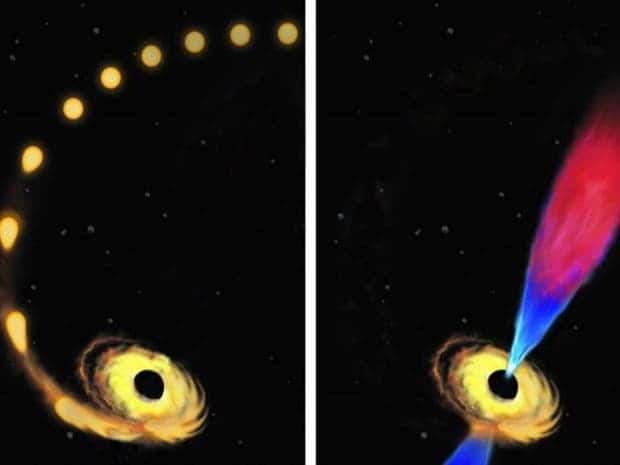
In 2014, telescopes that scour the night’s sky across the entire electromagnetic spectrum recorded a rare event: powerful X-rays emitting from a supermassive black hole that was feeding on a hapless star. But that was not all. Roughly 13 days later, scientists picked up a radio signal that reverberated in the same pattern as the X-ray light. “In other words, the radio emission appears to be an echo of the X-ray emission,” said Sjoert van Velzen, a New York University postdoctoral fellow. This is an important observation that will not only help scientists come to better grips with the mysteries of black holes but also how galaxies evolve.
A dying star’s echoes
At the heart of nearly all galaxies lies a supermassive black hole — which can be anywhere in the order of hundreds or thousands to billions of solar masses. Thanks to recent developments, astrophysicists have come to learn that such black holes are inexorably linked to the galaxies that encircle them. For instance, the bigger the galaxy, the more massive the supermassive black hole will be, and vice-versa. Also, the larger the black hole, the faster stars in the outer regions of the galaxy will travel.
Given their ubiquity, it is now commonly thought that black holes play a fundamental role in the formation and evolution of the universe. This may sound like an odd assertion seeing how, traditionally, most people view black holes as insatiable objects that look more like destroyers than creators. “Nothing can escape the clutches of a black hole, not even light,” is an often repeated aphorism. But, while black holes are famous for their gargantuan appetite, they also have a role to play in dispersing huge quantities of matter and energy across millions of light-years.
An obvious example of this is the so-called tidal disruption event, which occurs when a star gets to close to a black hole’s event horizon (the point of no return) and starts irreversibly getting pulled towards its center. The star essentially gets pulled apart by the phenomenal gravitational forces, forming a disk around the black hole. While the debris disk spirals towards the black hole, in the process it heats to up to temperatures of a million degrees Celsius, causing the emission of X-rays from the inner part of the accretion disk. Meanwhile, optical and ultraviolet emissions propagate from the outer part of the disk.
However, researchers at NASA’s Goddard Space Flight Center found that the tidal disruption flare ASASSN-14li, located 300 million light-years away, also emitted a radio flux. The radio pattern correlated with the X-ray emissions fired by the flare only 13 days earlier.
“Because X-rays originate from the hot material falling in and powering the black hole, this coupling between the X-ray and radio suggests that the radio emission must originate from a jet that is regulated by the inner accretion flow onto the black hole,” van Velzen said, co-author of the new paper published in the Astrophysical Journal.
The fact that the X-rays and radio emissions are coupled is no coincidence. The researchers say there’s a causal connection between the regions of the flare that sends X-rays and the one that emits radio waves. Specifically, it’s likely that, as the star gets engulfed by the black hole, a powerful jet of radiation and charged particles erupts from the feeding poles of the black hole. What’s more, the power of the jet is directly related to the rate at which the black hole devours the star.
“Our results show that the short-lived jet following a tidal disruption behave similar to jets from black holes that are active for millions of years,” said van Velzen. “This unified view of jet production should make it easier to include the impact of jets into models of galaxy evolution.”






